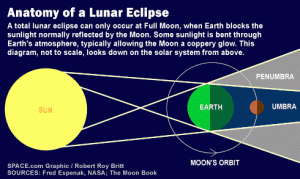Wake to a “Blood Moon” on Saturday
The full moon comes once every month, but this month, it brings something unusual. This full moon will be a “Blood Moon.”
According to Dr. Tony Phillips of NASA’s Science News, there will be a total eclipse of the moon visible from North America this Saturday, April 4. East of the Mississippi River, the eclipse will occur during sunrise, and will be a partial eclipse. West of the Mississippi, observers can expect to see the full moon illuminated by coppery red light as it hangs in the sky like an orb.
In his article “Total Eclipse of the Moon” Dr. Phillips explains why the moon appears red by asking viewers to imagine they are witnessing the eclipse from the surface of the moon, facing the Earth and the Sun behind it. Dr. Phillips writes
You might expect Earth seen in this way to be utterly dark, but it’s not. The rim of the planet looks to be on fire! As you scan your eye around Earth’s circumference, you’re seeing every sunrise and every sunset in the world, all of them, all at once. This incredible light beams into the heart of Earth’s shadow, filling it with a coppery glow and transforming the Moon into a great red orb when viewed from Earth (Dr. Tony Phillips 2015).
Weather provided, we Earthlings will get to see every sunset and sunrise that occurs this Saturday reflected simultaneously against the surface of the moon.
During the eclipse, light from the sun will pass through the Earth’s atmosphere, interacting with air molecules. As it does so, the red and copper-hued light released from their exchanges will be angled inward, around the earth in a phenomenon called refraction. Some of this light will hit the moon as it moves directly behind the Earth, causing it to be illuminated.
The setting of the moon will allow us to see only a fraction of this event. In fact, this eclipse will be relatively short, as Dr. Phillips notes, because in our view, the moon is only passing through the periphery of Earth’s shadow.
Total eclipses occur when viewers witness the moon in its “umbra,” or the inner portion of the Earth’s shadow and partial eclipses occur when the moon is in the “penumbra,” or outer portion of the Earth’s shadow. Although this eclipse will eventually pass fully into the umbra, it will not be visible in this stage on the East Coast.
Here in the North Country, we will witness the eclipse at its fullest just before moonset, at 6:31 am. The eclipse will begin at 5:01 am and end at 10:59 am, well after the sun has risen and the moon has set from our viewing position. Weather provided, early risers will see about half of the moon lit up with copper tones just before sunrise. Unlike a solar eclipse, this is a spectral delight that won’t hurt your eyes if viewed directly.
Fortunately, this event is part of a “tetrad” of total lunar eclipses. A tetrad is a series of four complete lunar eclipses separated by six month intervals. The next full lunar eclipse occur on September 28, 2015. On this occasion, Northern New York will have front row seats and we will see the moon fully illuminated.
For more information about lunar eclipses and why they happen when they do, check out this video from NASA’s ScienceCast series.
If you find yourself seeking a soundtrack to your lunar viewing experience, Dave Parkman of LA Weekly has generously created a playlist of the top five songs to listen to as you view a lunar eclipse. It should come as no surprise that Van Morrison’s “Moondance”, David Bowie’s “Space Oddity”, and Bonnie Tyler’s “Total Eclipse of the Heart” all made it onto the list.










Will probably be cloudy and maybe even snowing on Saturday morning.
How about listening to Debussey’s “Claire de Lune”, Beethoven’s “Moonlight Sonata” and Dvorak’s “Song to the Moon” (as sung by former Cranee Renee Fleming, of course)?